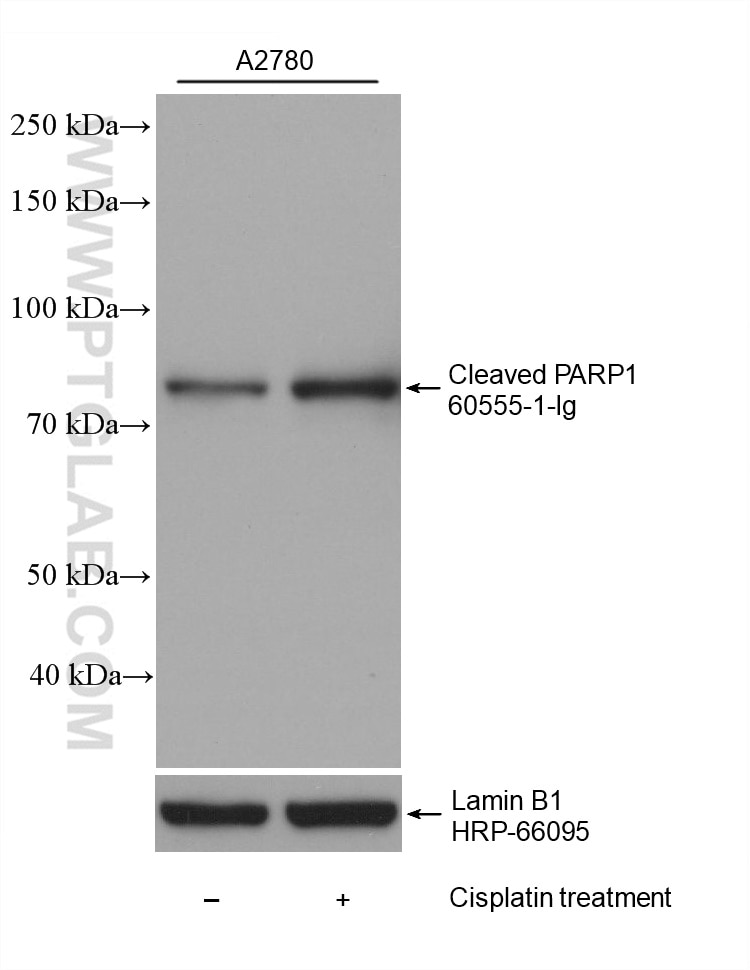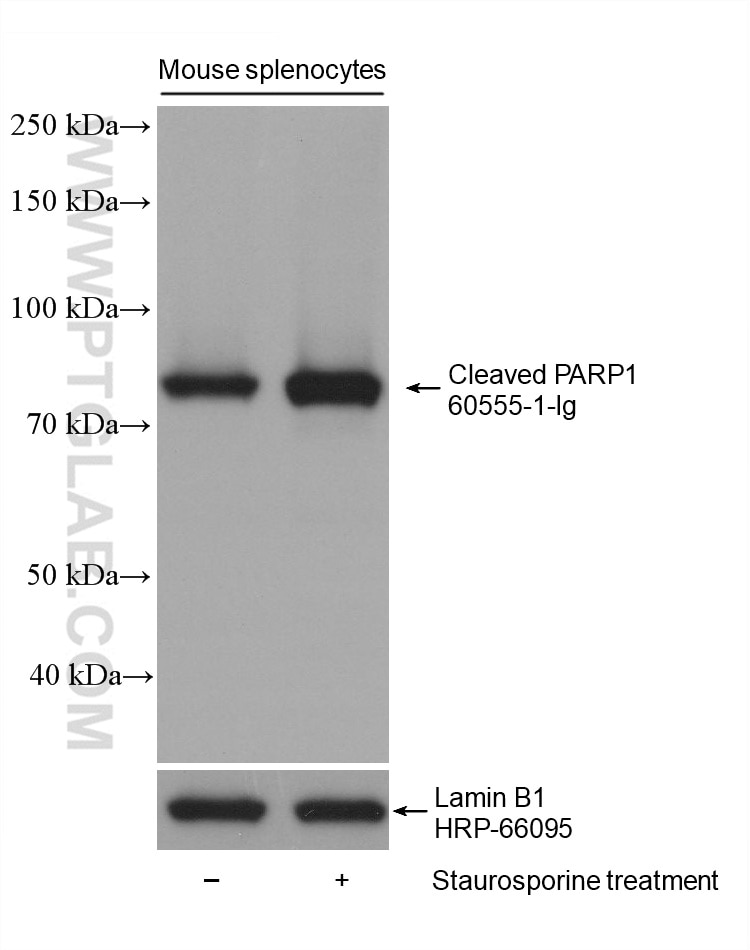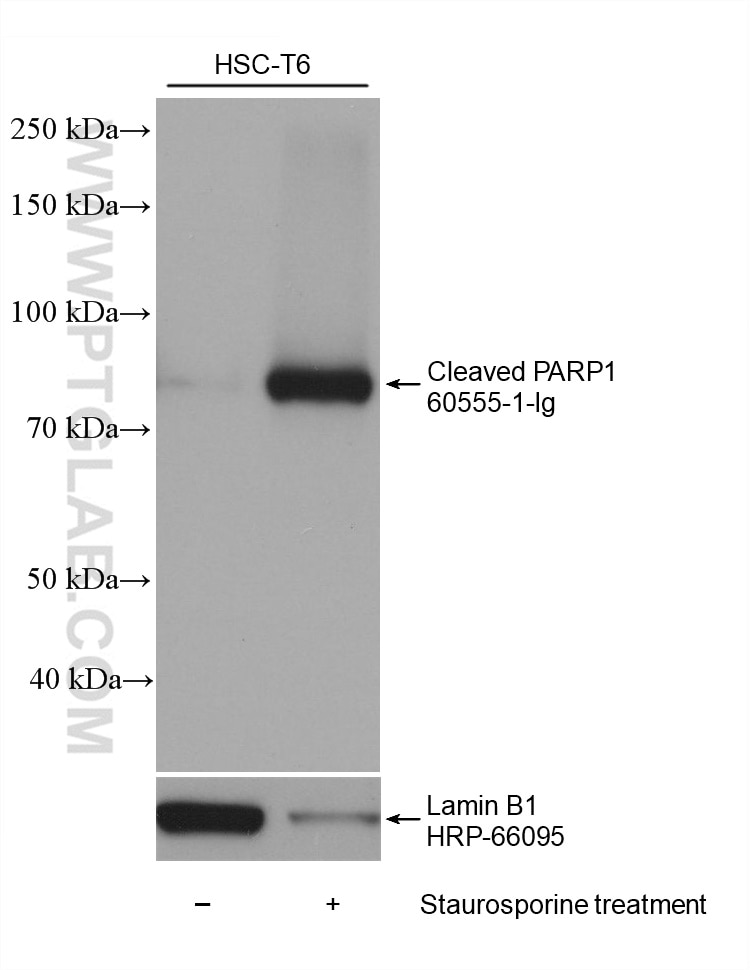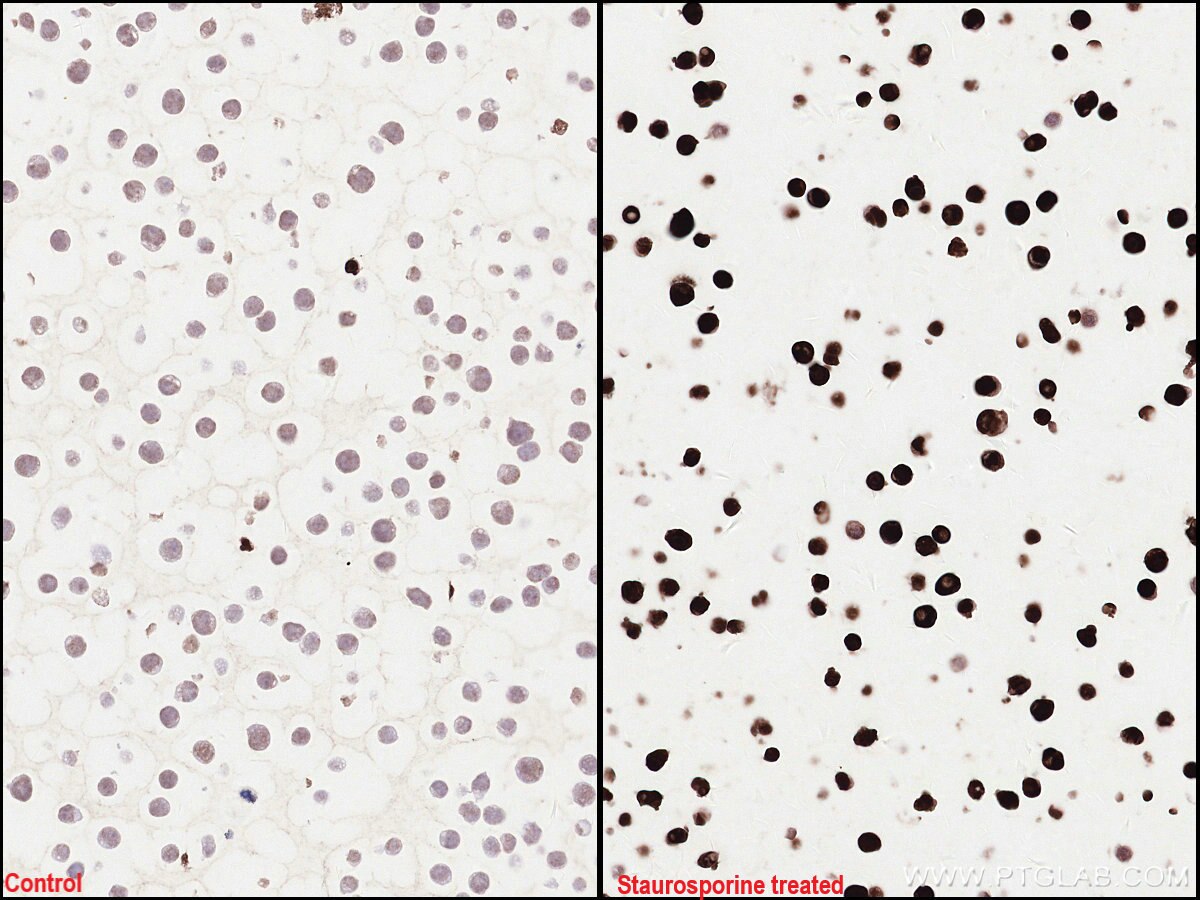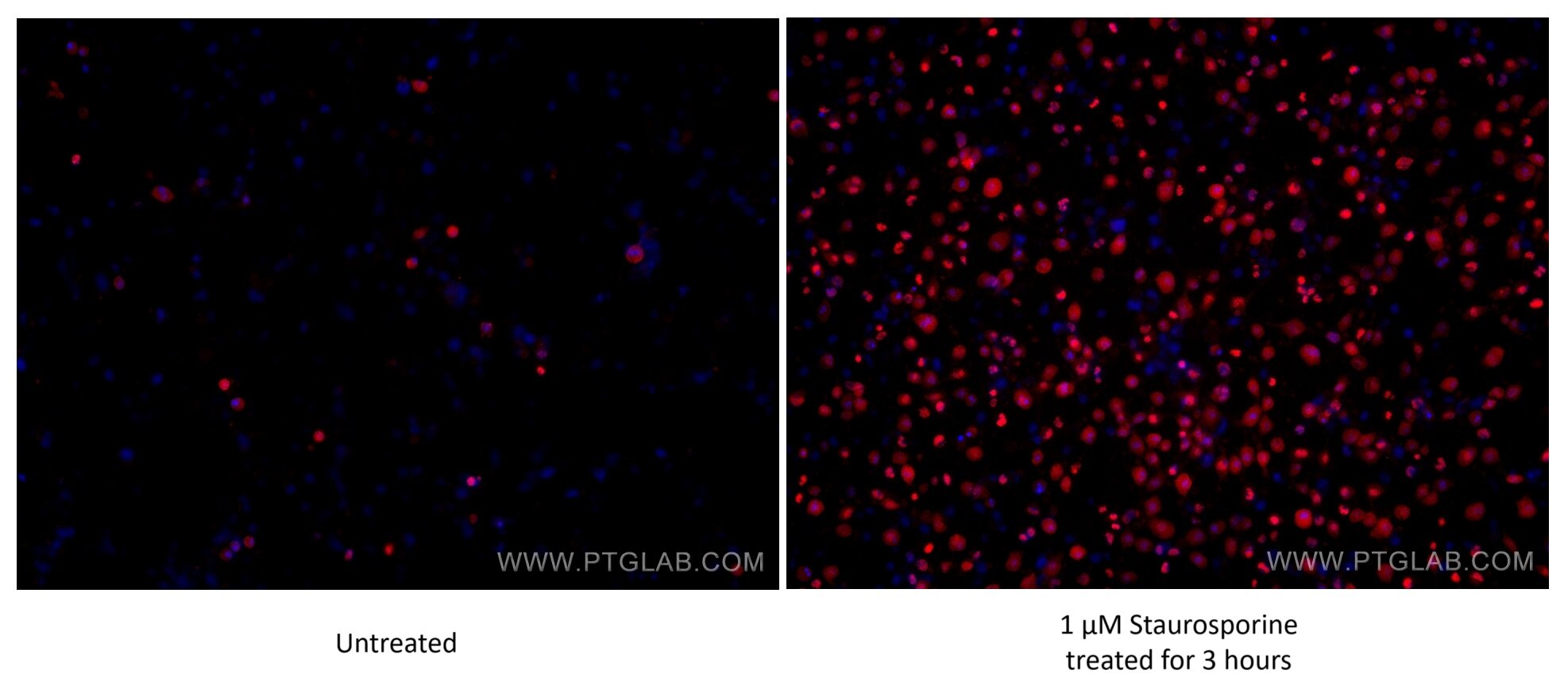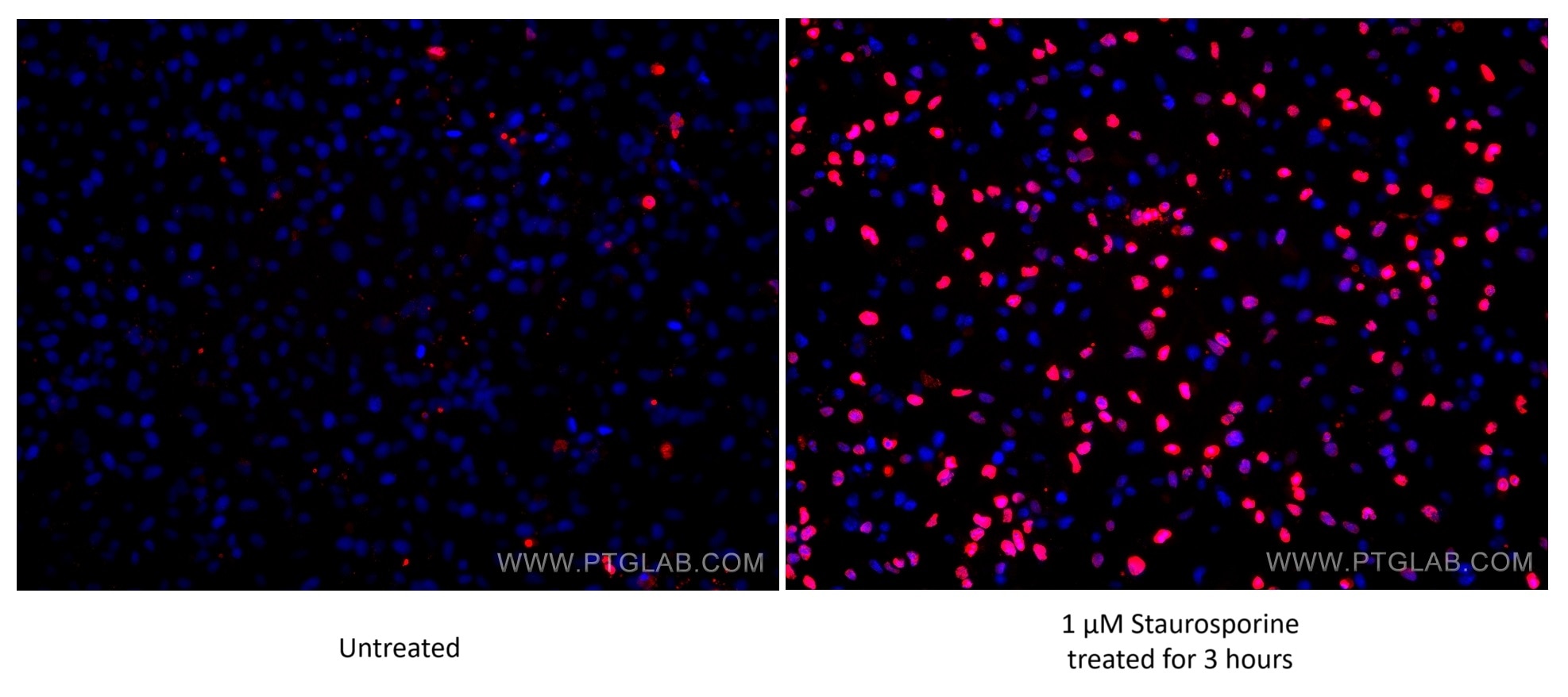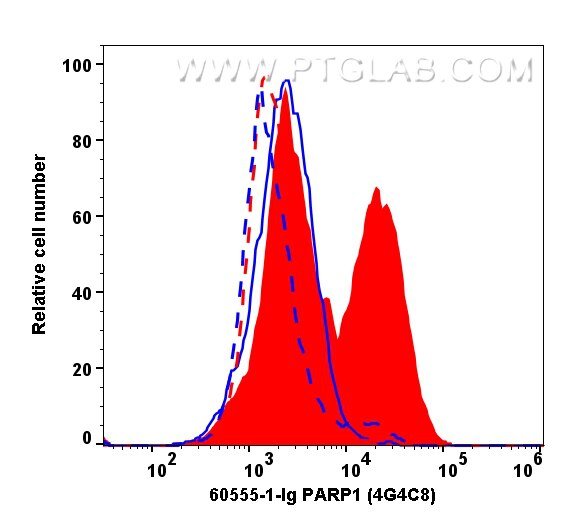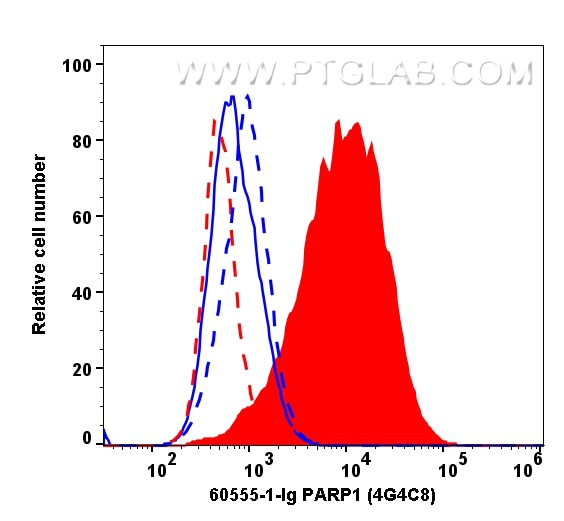Cleaved PARP1 Monoklonaler Antikörper
Cleaved PARP1 Monoklonal Antikörper für WB, IHC, IF/ICC, FC (Intra), ELISA
Wirt / Isotyp
Maus / IgG1
Getestete Reaktivität
human, Maus, Ratte
Anwendung
WB, IHC, IF/ICC, FC (Intra), ELISA
Konjugation
Unkonjugiert
CloneNo.
4G4C8
Kat-Nr. : 60555-1-Ig
Synonyme
Geprüfte Anwendungen
| Erfolgreiche Detektion in WB | A2780-Zellen, Maus-Splenozyten |
| Erfolgreiche Detektion in IHC | Jurkat-Zellen Hinweis: Antigendemaskierung mit TE-Puffer pH 9,0 empfohlen. (*) Wahlweise kann die Antigendemaskierung auch mit Citratpuffer pH 6,0 erfolgen. |
| Erfolgreiche Detektion in IF/ICC | 1 μM Staurosporine (3 hours) treated HSC-T6 cells, 1 μM Staurosporine (3 hours) treated HeLa cells |
| Erfolgreiche Detektion in FC (Intra) | 1 μM Staurosporine (3 hours) treated HSC-T6 cells, 1 μM Staurosporine (3 hours) treated HeLa cells |
Empfohlene Verdünnung
| Anwendung | Verdünnung |
|---|---|
| Western Blot (WB) | WB : 1:5000-1:50000 |
| Immunhistochemie (IHC) | IHC : 1:1000-1:4000 |
| Immunfluoreszenz (IF)/ICC | IF/ICC : 1:500-1:2000 |
| Durchflusszytometrie (FC) (INTRA) | FC (INTRA) : 0.40 ug per 10^6 cells in a 100 µl suspension |
| It is recommended that this reagent should be titrated in each testing system to obtain optimal results. | |
| Sample-dependent, check data in validation data gallery | |
Veröffentlichte Anwendungen
| WB | See 5 publications below |
Produktinformation
60555-1-Ig bindet in WB, IHC, IF/ICC, FC (Intra), ELISA Cleaved PARP1 und zeigt Reaktivität mit human, Maus, Ratten
| Getestete Reaktivität | human, Maus, Ratte |
| In Publikationen genannte Reaktivität | human, Maus |
| Wirt / Isotyp | Maus / IgG1 |
| Klonalität | Monoklonal |
| Typ | Antikörper |
| Immunogen | Peptid |
| Vollständiger Name | poly (ADP-ribose) polymerase 1 |
| Berechnetes Molekulargewicht | 1014 aa, 113 kDa |
| Beobachtetes Molekulargewicht | 89 kDa |
| GenBank-Zugangsnummer | BC037545 |
| Gene symbol | PARP1 |
| Gene ID (NCBI) | 142 |
| Konjugation | Unkonjugiert |
| Form | Liquid |
| Reinigungsmethode | Protein-G-Reinigung |
| Lagerungspuffer | PBS with 0.02% sodium azide and 50% glycerol |
| Lagerungsbedingungen | Bei -20°C lagern. Nach dem Versand ein Jahr lang stabil Aliquotieren ist bei -20oC Lagerung nicht notwendig. 20ul Größen enthalten 0,1% BSA. |
Hintergrundinformationen
PARP1 (poly(ADP-ribose) polymerase 1) is a nuclear enzyme catalyzing the poly(ADP-ribosyl)ation of many key proteins in vivo. The normal function of PARP1 is the routine repair of DNA damage. Activated by DNA strand breaks, the PARP1 is cleaved into an 85 to 89-kDa COOH-terminal fragment and a 24 kDa NH2-terminal peptide by caspases during the apoptotic process. The appearance of PARP fragments is commonly considered an important biomarker of apoptosis. In addition to caspases, other proteases like calpains, cathepsins, granzymes, and matrix metalloproteinases (MMPs) have also been reported to cleave PARP1 and give rise to fragments ranging from 42-89 kDa.
This antibody only recognizes the cleaved form of PAPR1 but not full-length PARP1.
Protokolle
| PRODUKTSPEZIFISCHE PROTOKOLLE | |
|---|---|
| WB protocol for Cleaved PARP1 antibody 60555-1-Ig | Protokoll herunterladen |
| IHC protocol for Cleaved PARP1 antibody 60555-1-Ig | Protokoll herunterladenl |
| IF protocol for Cleaved PARP1 antibody 60555-1-Ig | Protokoll herunterladen |
| STANDARD-PROTOKOLLE | |
|---|---|
| Klicken Sie hier, um unsere Standardprotokolle anzuzeigen |
Publikationen
| Species | Application | Title |
|---|---|---|
Bioorg Chem Synthesis and biological evaluation of novel isatin-phenol hybrids as potential antitumor agents | ||
Front Immunol An anoikis-related signature predicts prognosis and immunotherapy response in gastrointestinal cancers | ||
Int J Biol Macromol Matrix metallopeptidase 2-responsive curcumin-loaded nanoparticles-induced signal transducer and activator of transcription 3 inhibition suppresses glioblastoma multiforme growth via enhancing nuclear factor erythroid 2-related factor 2 activity | ||
Gene Epigenetic activation of PTEN by valproic acid inhibits PI3K/AKT signaling and Burkitt lymphoma cell growth | ||
Front Endocrinol (Lausanne) Bioinformatics analysis combined with experimental validation reveals the novel mechanisms of multi-targets of dapagliflozin attenuating diabetic liver injury |
